Student Union
STEM Jobs Lead List of Fastest-Growing Occupations
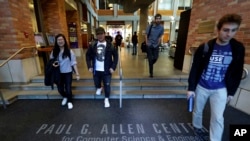
The number of STEM jobs — science, technology, engineering and mathematics — have sped past the number of non-STEM jobs by three times since 2000.
And experts say there might not be enough graduates in those fields to fill the jobs.
“Look around at how many times a day you touch a computer, tablet, phone … these industries are accelerating so much that these high school kids will have jobs that don’t even exist yet,” said Kenneth Hecht, the leader of the National STEM Honor Society, an membership program that engages students from kindergarten into their career in STEM project-based learning (NSTEM).
STEM covers both high-tech and long-established professions. For example, STEM jobs in demand include those in cloud computing, informatics and other software developers that write code for computation. They also include occupations for actuaries, cartographers, critical care nurses and epidemiologists.
Jobs in the medical and healthcare fields have boomed because of the COVID-19 pandemic, as populations age, but traditionally, computer technology, or tech, is the number one major that international students pursue within STEM, according to a study by the Institute of International Education.
Jobs in computer and information technology are projected to grow 11% from 2019 to 2029, according to the Bureau of Labor Statistics (BLS) website, “much faster than the average for all occupations.”
These occupations are projected to add about 531,200 new jobs to the U.S. workforce by 2029. Jobs in cloud computing, big data, and information security will be in high demand, according to BLS.
COVID plus and minuses
Recent enrollment declines because of the COVID-19 pandemic have slowed the pipeline between graduates and jobs, as most international students rode out the pandemic in their home countries. But recent graduates who land STEM jobs show greater availability and higher salaries.
“A STEM education and a STEM career can change the trajectory of one family’s path and even others,” said Kenneth Hecht, leader of the National STEM Honor Society that engages students from kindergarten into their career in STEM project-based learning (NSTEM).
Nidhi Thaker, a Ph.D. student in the biochemistry and molecular biology department at University of Massachusetts-Amherst, also is optimistic about the promise of STEM opportunities.
“Applying and combining a biology background with technology that can be helpful in making a product, and by product, I mean, it could be a machine, it could be a drug, it could be any other thing, to help medicine itself and to help the field grow,” is what biotechnology means to Thaker.
Her experience working in the Boston area, one of America’s biotech hubs and close to several top U.S. universities like Massachusetts Institute of Technology and Harvard University, has been largely positive.
“It’s not just work, work, work. They also incorporate, like, team-building exercises, going out and having parties and things like that,” Thaker noted. “It’s a very well rounded, cultural approach that they’re taking, in regard to giving all the benefits.”
Lack of people skills
One problem, though, is many graduates have a proficiency in tech skills but lack people skills, said Sahil Jain, senior enterprise architect at Adobe.
“This means they are good at coding. You can give them a digest code, they will do it very well. But they cannot speak to the senior leadership at the customer site.”
Jain explains that both soft and hard skills are necessary to do well in emerging technology jobs, yet students often excel at one or the other, not both.
“That means they are good at speaking, but when it comes to technicalities, the customer brings his architects on the call, ‘Oh, tell me how this will work? Can you give me some architectural aspects as well?’ … That is where the big gap is,” he explained.
In addition, Jain said the STEM job market is crowded with numerous evolving technologies.
“The industry is evolving a lot. It’s no longer only cloud computing based. There are many, many areas of blockchain,” a way to code to enhance the security of the information.
“We have machine learning, we have [artificial intelligence] ...” said Jain, who has recently enrolled in Georgia Institute of Techology, a public university in Atlanta, to keep his skills up to date.
Filling needed roles
Even with initiatives to alert students to STEM opportunities, like NSTEM, there were an estimated 2.4 million positions unfilled in STEM fields in 2018, according to a study by Impact Science, a California teacher-founded initiative to engage young students with science.
“Being on the educational side, these numbers are well published and well recognized in the world, and the question is and has been, ‘What do you do about it?’” Hecht asked.
“If you look at the differences in ethnicities and gender it would be even worse,” which inspires one of NSTEM’s missions to help close equity divisions in STEM, he added.
Immigration issues
An April 2021 study by the National Foundation for American Policy (NFAP) found that “enrolling more international undergraduate students does not crowd out U.S. students at the average American university and leads to an increase in the number of bachelor’s degrees in STEM majors awarded to U.S. students.”
“Each additional 10 bachelor’s degrees—across all majors—awarded to international students by a college or university leads to an additional 15 bachelor’s degrees in STEM majors awarded to U.S. students,” the study found. The data suggests that U.S. students are more likely to major in STEM fields if they go to school with international students.
“In much of the U.S., STEM graduates are in short supply. Students who graduate with a STEM major typically earn more than other graduates, especially early in their careers,” according to the NFAP study.
“The finding here that the presence of international students actually increases the number of U.S. students graduating with a STEM major is another reason to encourage international students to come to the United States,” stated Madeline Zavodny, the study’s author.
“America’s future competitiveness depends on attracting and retaining talented international students,” according to companies like Google, Facebook, Microsoft and Twitter with other parties in a group letter to Immigration and Custom Enforcement (ICE) in July 2020. ICE had announced it would revoke international student visas during the COVID-19 pandemic if those students were not in person to study on campus.
See all News Updates of the Day
- By VOA News
Competition grows for international students eyeing Yale
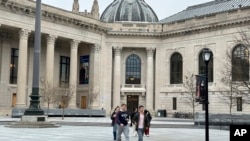
It’s tough to gain admission to Yale University, and it’s getting even tougher for international students as standout students from around the world set their sights on Yale.
The Yale Dale News, the campus newspaper, takes a look at the situation here.
- By VOA News
Student from Ethiopia says Whitman College culture made it easy to settle in

Ruth Chane, a computer science major from Ethiopia, writes about her experiences settling into student life at Whitman College in the U.S. state of Washington.
"The community at Whitman College made sure I felt welcomed even before I stepped foot on campus," she says.
- By VOA News
Claremont Colleges student gets a shock when she heads home to Shanghai
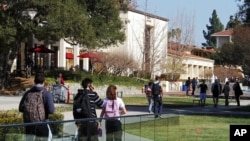
In The Student Life, the student newspaper for the Claremont Colleges, a consortium of five liberal art colleges and two graduate schools in Claremont, California, student Rochelle Lu writes about readjusting to her Shanghai home after spending a semester in the United States.
- By VOA News
Cedarville University aims to ease transition for international students
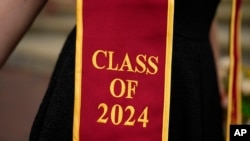
Cedarville University in the U.S. state of Ohio says it’s got more than 140 international students representing 44 countries.
Here, the school interviews Jonathan Sutton, director of international student services. He talks about his job and the opportunities for international students on campus.
- By VOA News
Morehouse College offers prospective students tips on applying and thriving
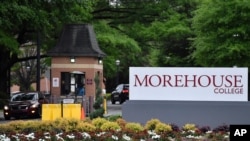
Morehouse College, a private, historically Black liberal arts college in the U.S. state of Georgia, offers a guide for international students interested in attending the school.
Among the tips to apply and thrive at Morehouse:
- Take advantage of the school’s orientation program
- Turn to the school’s Center for Academic Success for tutoring, support and more
- Immerse yourself in campus life via clubs and societies
- By Reuters
US reviews Columbia University contracts, grants over antisemitism allegations

The administration of President Donald Trump said on Monday it will review Columbia University's federal contracts and grants over allegations of antisemitism, which it says the educational institution has shown inaction in tackling.
Rights advocates note rising antisemitism, Islamophobia and anti-Arab bias since U.S. ally Israel's devastating military assault on Gaza began after Palestinian Hamas militants' deadly October 2023 attack.
The Justice Department said a month ago it formed a task force to fight antisemitism. The U.S. Departments of Health and Education and the General Services Administration jointly made the review announcement on Monday.
"The Federal Government's Task Force to Combat Anti-Semitism is considering Stop Work Orders for $51.4 million in contracts between Columbia University and the Federal Government," the joint statement said.
The agencies said no contracting actions had been taken yet.
"The task force will also conduct a comprehensive review of the more than $5 billion in federal grant commitments to Columbia University."
The agencies did not respond to requests for comment on whether there were similar reviews over allegations of Islamophobia and anti-Arab bias.
Columbia had no immediate comment. It previously said it made efforts to tackle antisemitism.
College protests
Trump has signed an executive order to combat antisemitism and pledged to deport non-citizen college students and others who took part in pro-Palestinian protests.
Columbia was at the center of college protests in which demonstrators demanded an end to U.S. support for Israel due to the humanitarian crisis caused by Israel's assault on Gaza. There were allegations of antisemitism and Islamophobia in protests and counter-protests.
During last summer's demonstrations around the country, classes were canceled, some university administrators resigned and student protesters were suspended and arrested.
While the intensity of protests has decreased in recent months, there were some demonstrations last week in New York after the expulsion of two students at Columbia University-affiliated Barnard College and after New York Governor Kathy Hochul ordered the removal of a Palestinian studies job listing at Hunter College.
A third student at Barnard College has since been expelled, this one related to the occupation of the Hamilton Hall building at Columbia last year.
Canada’s immigration overhaul signals global shift in student migration
From Europe to North America, nations are tightening their immigration policies. Now Canada, long seen as one of the world's most welcoming nations, has introduced sweeping changes affecting international students. The reforms highlight a growing global trend toward more restrictive immigration policies. Arzouma Kompaore reports from Calgary.
Trump administration opens antisemitism inquiries at 5 colleges, including Columbia and Berkeley
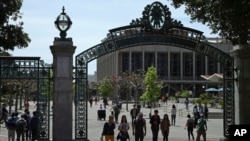
The Trump administration is opening new investigations into allegations of antisemitism at five U.S. universities including Columbia and the University of California, Berkeley, the Education Department announced Monday.
It's part of President Donald Trump's promise to take a tougher stance against campus antisemitism and deal out harsher penalties than the Biden administration, which settled a flurry of cases with universities in its final weeks. It comes the same day the Justice Department announced a new task force to root out antisemitism on college campuses.
In an order signed last week, Trump called for aggressive action to fight anti-Jewish bias on campuses, including the deportation of foreign students who have participated in pro-Palestinian protests.
Along with Columbia and Berkeley, the department is now investigating the University of Minnesota, Northwestern University and Portland State University. The cases were opened using the department's power to launch its own civil rights reviews, unlike the majority of investigations, which stem from complaints.
Messages seeking comment were left with all five universities.
A statement from the Education Department criticized colleges for tolerating antisemitism after Hamas' Oct. 7, 2023, attack on Israel and a wave of pro-Palestinian protests that followed. It also criticized the Biden administration for negotiating "toothless" resolutions that failed to hold schools accountable.
"Today, the Department is putting universities, colleges, and K-12 schools on notice: this administration will not tolerate continued institutional indifference to the wellbeing of Jewish students on American campuses," said Craig Trainor, the agency's acting assistant secretary for civil rights.
The department didn't provide details about the inquiries or how it decided which schools are being targeted. Presidents of Columbia and Northwestern were among those called to testify on Capitol Hill last year as Republicans sought accountability for allegations of antisemitism. The hearings contributed to the resignation of multiple university presidents, including Columbia's Minouche Shafik.
An October report from House Republicans accused Columbia of failing to punish pro-Palestinian students who took over a campus building, and it called Northwestern's negotiations with student protesters a "stunning capitulation."
House Republicans applauded the new investigations. Representative Tim Walberg, chair of the Education and Workforce Committee, said he was "glad that we finally have an administration who is taking action to protect Jewish students."
Trump's order also calls for a full review of antisemitism complaints filed with the Education Department since Oct. 7, 2023, including pending and resolved cases from the Biden administration. It encourages the Justice Department to take action to enforce civil rights laws.
Last week's order drew backlash from civil rights groups who said it violated First Amendment rights that protect political speech.
The new task force announced Monday includes the Justice and Education departments along with Health and Human Services.
"The Department takes seriously our responsibility to eradicate this hatred wherever it is found," said Leo Terrell, assistant attorney general for civil rights. "The Task Force to Combat Anti-Semitism is the first step in giving life to President Trump's renewed commitment to ending anti-Semitism in our schools."
- By VOA News
STEM, business top subjects for international students
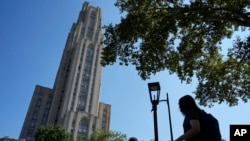
The Times of India breaks down the most popular subjects for international students to study in the U.S.
STEM and business lead the pack. Read the full story here. (January 2025)
- By VOA News
Safety and visa difficulties among misconceptions about US colleges

U.S. News & World report addresses some of the misconceptions about U.S. colleges and universities, including the difficulty of getting a visa.
Read the full story here. (January 2025)
- By VOA News
Work opportunities help draw international students to US schools
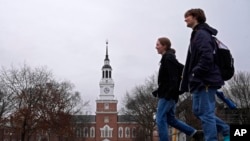
US News & World Report details the three top factors in foreign students' decision to study in the U.S. They include research opportunities and the reputation of U.S. degrees. Read the full story here. (December 2024)
- By VOA News
British student talks about her culture shock in Ohio
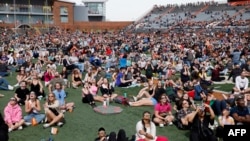
A British student who did a year abroad at Bowling Green State University in Ohio talks about adjusting to life in America in a TikTok video, Newsweek magazine reports.
Among the biggest surprises? Portion sizes, jaywalking laws and dorm room beds.
Read the full story here. (December 2024)
- By VOA News
Harvard's Chan School tells international students what to expect
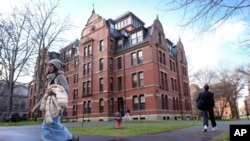
Harvard's T.H. Chan School of Public Health reaches out to international students by detailing the international student experience at the school.
Learn more about housing, life in Boston and more here.
- By Reuters
China unveils plan to build 'strong education nation' by 2035

China issued its first national action plan to build a "strong education nation" by 2035, which it said would help coordinate its education development, improve efficiencies in innovation and build a "strong country."
The plan, issued Sunday by the Communist Party's central committee and the State Council, aims to establish a "high quality education system" with accessibility and quality "among the best in the world."
The announcement was made after data on Friday showed China's population fell for a third consecutive year in 2024, with the number of deaths outpacing a slight increase in births, and experts cautioning that the downturn will worsen in the coming years.
High childcare and education costs have been a key factor for many young Chinese opting out of having children, at a time when many face uncertainty over their job prospects amid sluggish economic growth.
"By 2035, an education power will be built," the official Xinhua news agency said, adding that China would explore gradually expanding the scope of free education, increase "high-quality" undergraduate enrolment, expand postgraduate education, and raise the proportion of doctoral students.
The plan aims to promote "healthy growth and all-round development of students," making sure primary and secondary school students have at least two hours of physical activity daily, to effectively control the myopia, or nearsightedness, and obesity rates.
"Popularizing" mental health education and establishing a national student mental health monitoring and early warning system would also be implemented, it said.
It also aims to narrow the gap between urban and rural areas to improve the operating conditions of small-scale rural schools and improve the care system for children with disabilities and those belonging to agricultural migrant populations.
The plan also aims to steadily increase the supply of kindergarten places and the accessibility of preschool education.
- By VOA News
A look at financial aid options for international graduate students in US
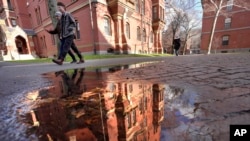
The Open Notebook, a site focusing on educating journalists who cover science, has complied a list of U.S. graduate program financial aid information for international students.









